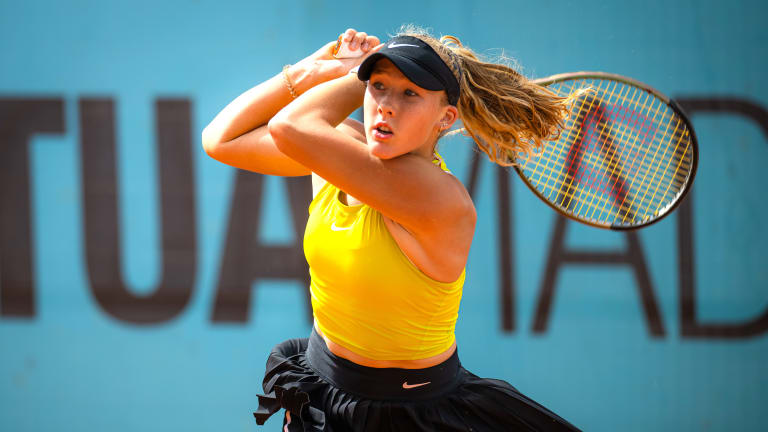One notable piece of preliminary data reveals that Andreeva has an older sister, 18-year-old Erika, who just this week reached a career-high ranking of No. 114. “Erika started at five or six, maybe even earlier, and since I'm her younger sister, I was always on the court, maybe since I was two,” Mirra told WTA Insider Courtney Nguyen earlier this week. “I was picking up some balls. But I started pretty late. I started at six.” Late? Really?
The Andreeva sisters first began tennis in Siberia and moved to Sochi for more tennis training. Then, after considering attending the Nadal Academy, they relocated to Cannes, France for work with coaches Jean-Christopher Faurel and Jean-Rene Lisnard.
Asked by Nguyen why she chose tennis, Andreeva said, “Actually, I didn't pick this sport. My mom did. I'm really happy that she did that because honestly, when my coaches give me five days to rest, I cannot even think [about] anything else [but] tennis. I'm really happy that my mom picked this sport because I feel that I really belong to this sport.”
Assume in time that more data will surface—the parents, the journey from Russia to France, the respective temperaments of each sister, off-court interests. Perhaps eventually, we’ll see a connection between Mirra Andreeva and three other tennis legends born on April 29, Andre Agassi and the twins, Bob and Mike Bryan.
But what about the clues? What are the deeper indicators? Consider the tennis. While Mirra considers Erika more a player in the vein of the powerful Iga Swiatek, her own stylistic role model is the crafty Ons Jabeur, favoring a game of guile and variety. Though versus Linette, Andreeva hardly drop-shotted with the frequency of Jabeur—who does?—she unquestionably has an appetite for tactical thinking, an eclecticism and court sense also reminiscent of Martina Hingis.
In many a rally in today’s match, Andreeva lofted the ball high, deep and crosscourt to set up the chance to crack one of her favorite shots, a powerful down-the-line backhand. She also hit a range of volleys, both the classic one with the lower edge of the frame nicely angled, as well as the more contemporary swing volley that at heart is simply a groundstroke in the air. Andreeva backed up her serve well too, winning an impressive 67 percent of her second serve points.
And here’s another clue. In the finals of her first ITF title run, Andreeva rallied to beat world No. 265 Celine Naef, 1-6, 7-6 (3), 6-0. The next week, versus Naef in the semis, Andreeva won much more comfortably, 6-1, 6-4. This suggests a studious quality, a sense that Andreeva pays close attention to each opponent and how she should go about the business of breaking up their game. “I just tried to cut the rhythm a lot,” said Andreeva about her strategy for playing Linette.
Andreeva’s approach reminds me of the court-savvy coach Judy Murray and the one word that matters most to her when working with a player: trouble. As Murray has often said, “Make trouble. Get out of trouble. Avoid trouble.” No doubt, Andreeva will need to rigorously apply all three of those principles versus Sabalenka. Up against tennis’ most recent Grand Slam champion, it will be fascinating to see how Andreeva’s news, data, and clues all come into play.
